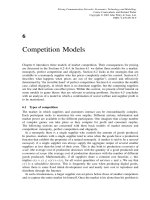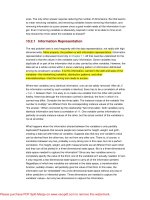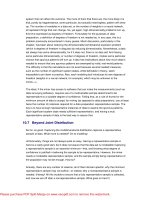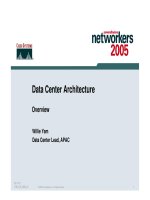Tài liệu Data Communication Principles P1 pptx
Bạn đang xem bản rút gọn của tài liệu. Xem và tải ngay bản đầy đủ của tài liệu tại đây (506.56 KB, 30 trang )
DATA COMMUNICATION
PRINCIPLES
For Fixed and Wireless Networks
This page intentionally left blank
DATA COMMUNICATION
PRINCIPLES
For Fixed and Wireless Networks
Aftab Ahmad
KLUWER ACADEMIC PUBLISHERS
NEW YORK, BOSTON, DORDRECHT, LONDON, MOSCOW
eBook ISBN: 0-306-47793-9
Print ISBN: 1-4020-7328-3
©2002 Kluwer Academic Publishers
New York, Boston, Dordrecht, London, Moscow
Print ©2003 Kluwer Academic Publishers
All rights reserved
No part of this eBook may be reproduced or transmitted in any form or by any means, electronic,
mechanical, recording, or otherwise, without written consent from the Publisher
Created in the United States of America
Visit Kluwer Online at:
and Kluwer's eBookstore at:
Dordrecht
NOTE TO INSTRUCTORS
As an aid to instructors interested in teaching this book as a course,
exercises suitable for use in a classroom setting are available by
contacting the author at
This page intentionally left blank
To my parents
This page intentionally left blank
Table of Contents
Preface
xv
1.
Computer Communications Networks - Introduction
1.1.
Main Components
1.1.1.
1.1.2.
1.1.3.
The Computer System
The Communications System
The Networking System
1.2.
Network Development Example
1.2.1.
Three Role Players
1.2.2.
Network Design
1.3.
Standardization
1.3.1.
1.3.2.
Example 1 -
Communication of Voice
Example 2 - File Transfer
1.4.
Classification of Networks
1.4.1.
1.4.2.
1.4.3.
Local Area Networks (LANs)
Wide Area Networks (WANs)
Metropolitan Area Networks (MANs)
1.5.
Network Protocol Architecture
1.5.1.
1.5.2.
1.5.3.
Protocols
Standards
Protocol Architecture
1.6.
Example of a Protocol Architecture
1.6.1.
Open System
1.7.
Summary
1.8.
Review Questions
Network Architectures - Examples
2.
2.1.
The OSI Reference Model (OSI-RM)
2.1.1.
2.1.2.
2.1.3.
2.1.4.
2.1.5.
OSI-RM Characteristics and Terminology
Communications Model within an OSI Node
Communications Across the OSI Network
Inter-layer communication
OSI-RM Layer Definitions and Functions
2.2.
The TCP/IP Protocol Suite
2.2.1.
2.2.2.
2.2.3.
2.2.4.
The Internet Protocol (IP)
The Transmission Control Protocol (TCP)
The Application Protocols for the Internet
Lower Layers of the Internet
1
2
2
3
4
5
5
6
9
9
10
12
12
12
13
13
13
13
14
14
15
15
16
17
18
18
19
22
23
25
36
39
40
41
41
x
2.3.
The IEEE Wireless Local Area Network (IEEE WLAN)
2.3.1.
2.3.2.
2.3.3.
2.3.4.
Local Area Networks
Wireless Local Area Networks
The Physical Layer (PHY)
The Medium Access Control (MAC) Layer
2.4.
2.5.
Framework for Studying a Protocol.
Standardization of Protocols
2.5.1.
2.5.2.
2.5.3.
2.5.4.
2.5.5.
2.5.6.
International Telecommunications Union (ITU)
The Internet Society
International Organization for Standardization (ISO)
European Telecommunications Standards Institute (ETSI)
American National Standard Institute (ANSI)
Institute of Electrical and Electronic Engineers (IEEE)
2.6.
2.7.
Summary
Review Questions
3.
Network and User Data
3.1.
3.2.
The Network Data
The Physical Layer Data
3.2.1.
3.2.2.
3.2.3.
3.2.4.
3.2.5.
3.2.6.
3.2.7.
3.2.8.
Sequence of Events and Definitions
Modulation of data and signals
Digital Encoding of Data
Non-Return to Zero (NRZ)
Multilevel Encoding
Manchester Coding
General Characteristics of Bit Encoding
Zero-substitution and nB/NB Translation
3.3.
Passband Modulation
3.3.1.
3.3.2.
The Carrier Signal
Analog Modulation
3.4.
Digital Modulation
3.4.1.
3.4.2.
3.4.3.
Amplitude Shift Keying (ASK)
Frequency Shift Keying (FSK)
Phase Shift Keying (PSK)
3.5.
The User Data
3.5.1.
3.5.2.
3.5.3.
3.5.4.
Digital Transmission of Voice
The Sampling Theorem
Pulse Coded Modulation (PCM)
Delta Modulation
3.6.
Text and Numerical Data
3.6.1.
ASCII (American National Standard Code for
Information
Interchange)
3.6.2.
ISO 8859-1 (ISO Latin -1)
42
42
43
45
46
47
48
49
49
50
50
50
51
52
53
55
56
57
57
67
70
71
72
73
74
75
76
76
77
80
80
81
82
84
84
85
85
91
93
94
95









